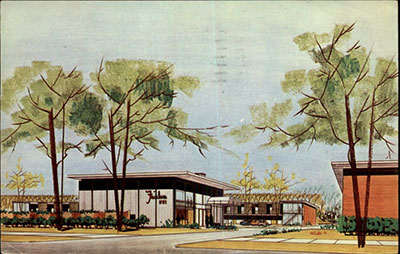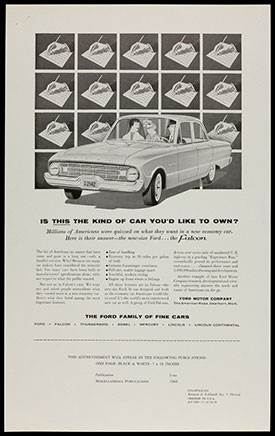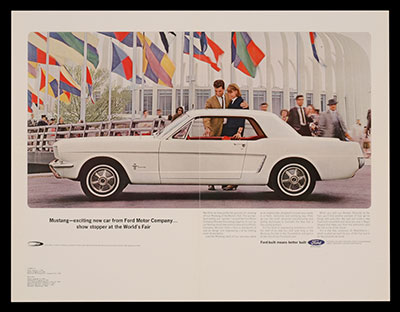| |
Iacocca
Lee Iacocca made no small plans. He joined Ford Motor Company’s sales department at 22 and resolved to be a vice president by 35. Technically, he failed to meet his goal; Iacocca wasn’t named Vice President and General Manager of the Ford division until November 1960, a few weeks after he turned 36. Any disappointment was quickly tempered when Ford President Robert McNamara joined John F. Kennedy’s cabinet and Iacocca was elevated to the top spot.
Iacocca brought a needed shot of vigor to the Blue Oval in the early 1960s. Ford had been a celebrated performance brand in earlier years. The hot rod hobby literally was built on the Ford flathead V-8 engine. But Chevrolet introduced a small block V-8 and sharp styling in the mid 1950s, and Ford suddenly looked stuffy. The Edsel didn’t help. The would-be wondercar debuted to public indifference in 1957 and stuck the company with a $250 million loss. The upscale Thunderbird, introduced for 1955, was a notable bright spot, but it grew from two to four seats for 1958 and lost much of its cool cachet. In 1960, Ford’s best-seller was the compact Falcon. It was a solid car, but no one would mistake it for exciting. Iacocca, a salesman at heart, sensed almost limitless customer potential in the baby boomers, then entering their teens on the push to adulthood. If only Ford had a car for them.
The Fairlane Committee
In the wake of the Edsel fiasco, any talk of a new car was heresy at Ford. Iacocca assembled a small team of trusted advisors to ponder his proposed “youth car.” He realized that the team would work better away from the unconvinced eyes at the main office. The stately Dearborn Inn was the traditional haunt of Ford’s C-Suite executives, but they were just the types Iacocca hoped to avoid. Instead, he huddled his group at the Fairlane Inn, a newish motor lodge two miles west of World Headquarters.
 |
| Dearborn’s Fairlane Inn, depicted here on a circa 1960 postcard, was home to the clandestine meetings that launched the Mustang. THF116226 |
The “Fairlane Committee” settled on several broad goals for the car. It had to seat four passengers. It needed an ample trunk. The hood should be long – to suggest a powerful engine, while the rear deck should be short – to suggest lithe speed. The car would have a multitude of options allowing the customer to personalize it. The weight had to stay under 2,500 pounds and the base price had to hold below $2,500. Finally, to ensure maximum publicity, the car had to launch in April 1964 at the New York World’s Fair. The fair promised global press attention. The spring launch ensured that Ford’s new car wouldn’t have to share the media spotlight with competitors’ cars unveiled in the fall.
The Look, The Name
Iacocca will forever be “Father of the Mustang,” but Hal Sperlich, Ford Special Projects Assistant, is credited with what may be the single most important idea in the Mustang’s development: to build the car on the Ford Falcon chassis. Creating the Mustang from scratch would’ve meant $400 million in development costs. It was an impossible sum post-Edsel, and it never would’ve let Ford sell the car profitably under $2,500. Dull or not, the Falcon was a proven platform close in size to the proposed youth car. Sperlich’s revelation was a breakthrough.
 |
| By building the Mustang on the Falcon’s chassis, Ford saved money and time. THF201715 |
Throughout the spring and summer of 1962, Ford’s design team struggled to turn Iacocca’s dream car into tangible clay models. No fewer than 18 versions were brought for his review, and none was judged suitable. Believing that competition spurred creativity, Iacocca organized an in-house contest. Designers from the Ford division, the Lincoln-Mercury division, and Ford’s Advance Projects department were pitted against each other. Iacocca’s scheme worked. The stylists got caught up in the excitement and, in just three weeks, had six different proposals.
The Ford division’s team won with a design we all would recognize as “Mustang.” But, in August 1962, it wasn’t “Mustang” just yet – naming a car is no simple matter. Automakers look for names that are strong, evocative, memorable, and free of existing trademark restrictions. The best ideas tend to be spoken for, and second choices often come around again on later models. Consider some of the names Iacocca and his team pondered for their new car: “Monte Carlo,” “Monaco,” “Torino” and “Cougar.” Each one eventually appeared on an automobile – with “Cougar” actually going to Mustang’s Mercury-branded cousin.
“Mustang” was not a new moniker to Ford. The company unveiled an experimental car with that name in October 1962. But, contrary to popular belief, that concept car had nothing to do with Iacocca’s production car. Indeed, research suggests that even the name “Mustang” came to each car separately. For the production car, the J. Walter Thompson advertising agency, at the behest of Ford, scoured the dictionary for animal names. While the similarly equestrian “Bronco” and “Colt” both came up (again, no good name goes unused in the auto industry), it was “Mustang” that captivated the ad men. It evoked open spaces, the American West and untamed freedom. Iacocca loved it.
With the basic design and name set, there was still one person to convince – the one person who could cancel the whole project. Henry Ford II gave his blessing in September 1962 with just three caveats: 1.) It had to be built for $45 million rather than the $75 million Iacocca asked, 2.) It needed an inch more legroom in the backseat and 3.) It had to sell.
Iacocca knew his job was on the line if the Mustang flopped.
Mustang Mania
With launch day just 18 months away, remaining styling and production issues were quickly resolved. The first pre-production cars rolled off of Ford’s Rouge assembly line on February 10, 1964. Never meant for sale, these early cars were promotional pieces shipped to far-flung dealers so that everybody had a physical car to show on April 17. Twelve of these early Mustangs became ride vehicles at Ford’s “Magic Skyway” attraction at the World’s Fair. One, with the auspicious serial number 00001, fell into the hands of a Canadian pilot who squabbled with Ford for two years before trading it back.
For an automaker, maybe the only thing worse than a flop is a hit that you can’t build fast enough to keep up with demand. Ford had the capacity and, to its lasting credit, it gambled when the company opened additional Mustang assembly lines in New Jersey and California. It proved a wise bet.
 |
| The Mustang, “show stopper at the World’s Fair.” By premiering its new car at the fair, Ford ensured maximum publicity. THF77007 |
The Mustang’s roll-out was masterful. Ads ran in 2,600 newspapers across the United States. Primetime commercials ran on all three networks the night before the launch. The car, alongside Lee Iacocca, simultaneously appeared on the covers of Time and Newsweek. Some 22,000 sales were tallied before the first weekend was over. Within a year, 418,812 Mustangs were sold. By the end of the model year, in the fall of 1965, almost 681,000 cars found their way into owners’ garages.
It was an unprecedented smash, and only the beginning of a five-decade run that shows no sign of stopping. What was the secret of the Mustang’s success? It was the right car at the right time. Lee Iacocca’s instincts on the baby boomers were dead on. Young people wanted a car that looked sporty, had a modest price, and could be accessorized to their individual tastes. General Motors, Chrysler and AMC had nothing to match it, giving Ford a lock on an untapped market. (To be sure, Camaro, Firebird, Challenger and Javelin were soon to come.) The splashy, media-savvy debut didn’t hurt either. Few cars had so much going for them. Fewer, still, have kept it going for 50 years… and counting!
| |
-- Matt Anderson, Curator of Transportation |
|

